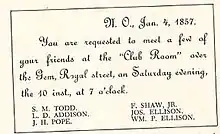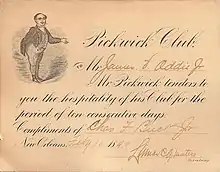The Pickwick Club
The Pickwick Club is a private gentlemen's club in New Orleans, Louisiana.[1] Founded in 1857, The Pickwick Club and the Mystic Krewe of Comus were originally one group comprising two organizations. After The Boston Club, The Pickwick Club is the second oldest remaining in the city.
| Location |
|
|---|
History

The history of social clubs in New Orleans began with The Elkin Club, founded 1832 and folded in 1838, was an open club that sponsored dances and balls in the vicinity of Bayou St John and closed due to the financial crisis of 1837. The Pelican Club, founded 1843 and folded at the beginning of the Civil War, confined its membership through blackball policies to bankers, cotton brokers, attorneys, physicians and political leaders; the smallest lapse in credit spelled denial of membership. Younger gentlemen, who had been rejected membership to the Pelican Club, organized The Orleans Club in 1851 with similar, yet less restrictive, membership policies; but similarly shuttered its doors, never to reopen, at the outset of the Civil War. It was the ex-members of The Orleans Club, who would have themselves organized a carnival celebration, that would go on to form The Pickwick Club.[2]
In 1857 a group of men, some former Orleans Club members, who resided in the Anglo-American neighborhoods of New Orleans, met in the Club Room of the Gem Saloon-a former residence of William Parker of Natchez, located at Old No 17 Royal Street (127 Royal Street).[3] The idea was initially conceived at Pope’s pharmacy on the corner of Jackson and Prytania. Six gentlemen (originally from Mobile, Alabama) sent out an invitation to a select group of friends to meet at the Gem Saloon, where The Pickwick Club and the first carnival organization the Mistick Krewe of Comus was organized.

The Pickwick, unlike the Boston Club, began as a "closed club," but evidence suggests before the turn of the 19th century the club allowed members to extend the club's hospitality to out of town guests during Carnival.
Background
Mobile, Alabama, the former capital of French Louisiana, had adopted Mardi Gras celebrations sometime before New Orleans. There the earliest mystic society formed was known as the Cowbellions de Rakin Society. These revelers, known as Cowbellions, a few of whom emigrated to New Orleans, decided to continue their carnival traditions there.[4]
Notable members
- Adley H. Gladden, First President, was lieutenant colonel and second commander of the Palmetto Regiment of South Carolina volunteers during the Mexican–American War and a brigadier general in the Confederate States Army during the American Civil War.[5][6]
- Col. Henry C. Merriam, was a United States Army general. He received the United States military's highest decoration, the Medal of Honor, for his actions as a Union officer in command of African American troops during the American Civil War. He built and owned The Crescent City Billiard Hall.[7]
- William J. Behan, was an American Confederate veteran and politician. He served as the 41st mayor of New Orleans (November 20, 1882 – April 28, 1884).[8]
- Edward Douglass White, American politician and jurist, was a United States Senator and the ninth Chief Justice of the United States. He served on the Supreme Court of the United States from 1894 to 1921. He is best known for formulating the Rule of Reason standard of antitrust law.[9]
- Harry T. Hays was an American Army officer serving in the Mexican–American War and a general who served in the Confederate Army during the American Civil War.[10]
- Paul Capdevielle was mayor of New Orleans, Louisiana, from May 9, 1900 to December 5, 1904.[11]
- Charles de Choiseul, Confederate States Army officer during the American Civil War serving under Harry T. Hays; son of French Nobleman Charles de Choiseul-Praslin.
- Dr. Robert Tayloe Cook V, MD, FFV, of the Tayloe's of Mount Airy, VA. His uncle, H Tayloe, founded the Fair Grounds in 1838 with Marigny. Doctor of radiology at Baptist Hospital and past president of the Louisiana SNMMI. Club President Edward Douglass White,[12] LD Addison, founder of MKC; Dick Taylor; J Grymes, and J Randolph of Nottoway, were relations.[13][14][15]
Homes of The Pickwick Club
- Tchoupitoulas Street just above Poydras Street 1857 – January 1858
- No. 57 St. Charles Street, just beyond Gravier Street 1858–1865
- The corner of Canal and Exchange Alley Streets 1865–1881
- Canal Street (Today, 824 Canal Street-The Boston Club)1881–1882
- The corner of Canal and Carondelet Streets 1882–1894
- No.4 Carondelet Street 1894–1899
- 1028 Canal Street 1899–1934
- Unknown 1934–1950
- The Crescent City Billiard Hall, corner of Canal St and St Charles Ave, 1950–present[16]
See also
References
- "10 Exclusive Places In New Orleans You'll Never Get IntoThe Pickwick Club". Complex.com. Retrieved 4 October 2018.
- New Orleans Carnival Krewes: The History, Spirit & Secrets of Mardi Gras, Rosary O'Neill, Arcadia Publishing, Feb 11, 2014.
- "A Multifaceted Gem : Known variously through the years as the Gem Coffee House, Café, Oyster House and Saloon, its origins are shrouded in mystery" (PDF). Neworleansbar.org. Retrieved 4 October 2018.
- Augusto P. Micelli, The Pickwick Club of New Orleans, (New Orleans: Pickwick Press, Hauser Printing CO. 1964),1-2.
- New Orleans Carnival Krewes: The History, Spirit & Secrets of Mardi Gras, Rosary O'Neill, Arcadia Publishing, Feb 11, 2014.
- http://www.storyvilledistrictnola.com/club_index.html
- https://www.pbs.org/wgbh/americanexperience/features/neworleans-pickwickians-and-reconstruction/
- https://www.pbs.org/wgbh/americanexperience/features/neworleans-pickwickians-and-reconstruction/
- https://www.pbs.org/wgbh/americanexperience/features/neworleans-pickwickians-and-reconstruction/
- Lords of Misrule: Mardi Gras and the Politics of Race in New Orleans, James Gill, Univ. Press of Mississippi, 1997, p. 77
- Standard History of New Orleans, Louisiana: Giving a Description of the Natural Advantages, Natural History, Settlement, Indians, Creoles, Municipal and Military History, Mercantile and Commercial Interests, Banking, Transportation, Struggles Against High Water, the Press, Educational ..., Henry Rightor, Lewis Publishing Company, 1900
- https://famouskin.com/famous-kin-menu.php?name=29462+elizabeth+tayloe
- Times Picayune Newspaper, January 18, 2013, Obituaries
- The Tayloes of Virginia and Allied Families, Tayloe, Walter Randolph, Published 1963, Berryville, VA, p. 85
- Tyler, Lyon Gardiner, ed. (April 1915). "The F. F. V.'s of Virginia". William and Mary College Quarterly Historical Magazine. Richmond, Virginia: Whittet & Shepperson. p. 277.
- New Orleans Nostalgia "Trouble, Right Here in the River City" Ned Hémard Copyright 2009